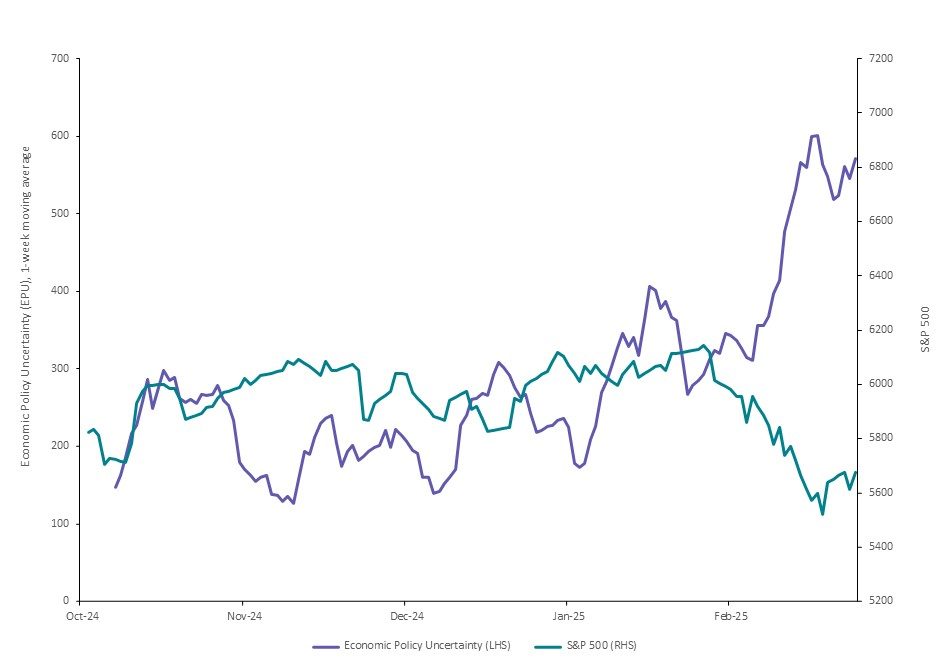
Authors & Contributors
Bond vigilantes have historically held policymakers accountable, but recent market shifts indicate that equity markets may be the ones whose actions effect policy change.
What does it mean to be a bond vigilante? The term was coined in the 1980s to describe investors who offload bonds in protest of fiscal or monetary policies deemed as inflationary, driving yields up and increasing borrowing costs for government issuers.
Fast forward to March 2025 – the US Treasury bond markets are broadly calm and in balance despite rising upside risks to inflation related to expected policy shifts in four key areas: trade, regulation, taxes and immigration. All this against the backdrop of a Federal Reserve (Fed) that continues to signal additional rate cuts this year. The yield on 10-year US Treasury Notes closed at 4.43% the day after the election, rose to a high of 4.79% in January just before the Inauguration and fell to 4.24% following the Fed’s latest policy meeting on March 19. Falling yields do not seem to suggest that an inflation shock is imminent but are instead consistent with a broader risk-off move.
Economic Policy Uncertainty and the S&P 500®

Source: Bloomberg as of 3/19/25. Economic Policy Uncertainty (EPU) is a 1-week moving average.
Are equity markets taking on the vigilante role instead? Following Election Day, market enthusiasm drove US equity market valuations to all-time highs on February 19. However, between then and March 19, the S&P 500® and the Nasdaq-100 have fallen by 7.6% and 11.0%, respectively. Although US equity markets experienced a relief rally following the Fed’s rate decision on March 19, investors remain sensitive to announcements on the new administration’s economic policies, especially tariffs.
While President Trump often pointed to the performance of US equity markets as a measure of success during his first term, this has not been the case in the early days of the second term. Rather, the administration has been clear that they are taking a Main Street versus Wall Street approach, focusing more on housing costs, gas prices and mortgage rates. Equity market swings have been shrugged off until this point, but the market reaction may be more significant if bond vigilantes join the fray. A sustained rise in longer-term rates like 10-year Treasuries and mortgages could be hard to ignore.
PAST PERFORMANCE IS NOT NECESSARILY INDICATIVE OF FUTURE RESULTS.
All investments involve risk, including the possible loss of principal. Certain investments have specific or unique risks. No investment strategy or risk management technique can guarantee returns or eliminate risk in any market environment.
This material has been provided for informational purposes only and should not be construed as investment advice or a recommendation of any particular investment product, strategy, investment manager or account arrangement, and should not serve as a primary basis for investment decisions. Prospective investors should consult a legal, tax or financial professional in order to determine whether any investment product, strategy or service is appropriate for their particular circumstances. This document may not be used for the purpose of an offer or solicitation in any jurisdiction or in any circumstances in which such offer or solicitation is unlawful or not authorized. Views expressed are those of the author stated and do not reflect views of other managers or the firm overall. Views are current as of the date of this publication and subject to change. This information may contain projections or other forward-looking statements regarding future events, targets or expectations, and is only current as of the date indicated. There is no assurance that such events or expectations will be achieved, and actual results may be significantly different from that shown here. The information is based on current market conditions, which will fluctuate and may be superseded by subsequent market events or for other reasons. References to specific securities, asset classes and financial markets are for illustrative purposes only and are not intended to be, and should not be, interpreted as recommendations. Charts are provided for illustrative purposes and are not indicative of the past or future performance of any BNY product. Some information contained herein has been obtained from third party sources that are believed to be reliable, but the information has not been independently verified. No part of this material may be reproduced in any form, or referred to in any other publication, without express written permission.
Indices referred to herein are used for comparative and informational purposes only and have been selected because they are generally considered to be representative of certain markets. Comparisons to indices as benchmarks have limitations because indices have volatility and other material characteristics that may differ from the portfolio, investment or hedge to which they are compared. The providers of the indices referred to herein are not affiliated with Mellon Investments Corporation (MIC), do not endorse, sponsor, sell or promote the investment strategies or products mentioned herein and they make no representation regarding the advisability of investing in the products and strategies described herein. Investors cannot invest directly in an index.


